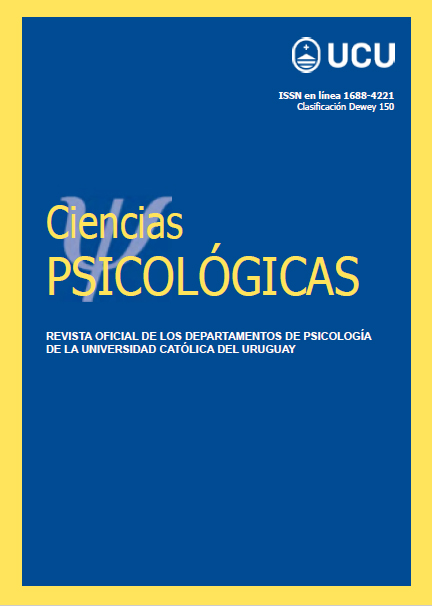Propiedades psicométricas del Patient Health Questionnaire-4 en una muestra de adultos del Ecuador
DOI:
https://doi.org/10.22235/cp.v19i2.4481Palabras clave:
ansiedad, depresión, equivalencia de medida, fiabilidad, validezResumen
Objetivo: Analizar las propiedades psicométricas del Patient Health Questionnaire-4 (PHQ-4) en una muestra de adultos de Ecuador. Método: Estudio de carácter psicométrico en el que se analizan la validez factorial, la equivalencia de medida diferenciada por el género y la consistencia interna del instrumento. Participantes: 406 adultos ecuatorianos, el 68.47 % corresponden a mujeres, con edades entre 18 y 59 años (M = 27.43; DE = 8.20). Resultados: Se confirma el modelo oblicuo de dos factores del PHQ, con las dimensiones de depresión y ansiedad. Además, la medida es equivalente a nivel escalar a partir del género. La consistencia interna es adecuada y presenta una validez divergente con medidas de bienestar general. Conclusión: El PHQ-4 es un instrumento válido y confiable para la evaluación rápida de la ansiedad y la depresión en adultos de Ecuador.
Descargas
Citas
American Psychiatric Association. (2014). Manual diagnóstico y estadístico de los trastornos mentales. DSM-5 (5a ed.). Editorial Médica Panamericana.
Anxiety and Depression Association of America (2023). Understand the Fact. https://adaa.org/understanding-anxiety
Asher, M., & Aderka, I. M. (2018). Gender Differences in Social Anxiety Disorder. Journal of Clinical Psychology, 74(10). https://doi.org/10.1002/jclp.22624
Asparouhov, T., & Muthén, B. (2014). Multiple-group Factor Analysis Alignment. Structural Equation Modeling, 21(4), 495-508. https://doi.org/10.1080/10705511.2014.919210
Ato, M., López, J. J., & Benavente, A. (2013). Un sistema de clasificación de los diseños de investigación en psicología. Anales de Psicología, 29(3), 1038-1059. https://doi.org/10.6018/analesps.29.3.178511
Beck, A. T., Epstein, N., Brown, G., & Steer, R. (1988). An Inventory for Measuring Clinical Anxiety: Psychometric Properties. Journal of Consulting and Clinical Psychology, 56(6), 893-897. https://doi.org/10.1037/0022-006X.56.6.893
Beck, A., Steer, R., & Brown, G. (1996). Manual for the Beck Depression Inventory—II. Psychological Corporation.
Berry, K., Sheardown, J., Pabbineedi, U., Haddock, G., Cross, C., & Brown, L. J. E. (2020). Barriers and Facilitators to Accessing Psychological Therapies for Severe Mental Health Difficulties in Later Life. Behavioural and Cognitive Psychotherapy, 48(2). https://doi.org/10.1017/S1352465819000596
Browne, M. W., & Cudeck, R. (1992). Alternative Ways of Assessing Model Fit. Sociological Methods & Research, 21(2). https://doi.org/10.1177/0049124192021002005
Byrne, B. M. (2008). Testing for Multigroup Equivalence of a Measuring Instrument: A Walk Through the Process. Psicothema, 20(4). https://www.psicothema.com/pdf/3569.pdf
Carranza Esteban, R. F., Mamani-Benito, O., Cjuno, J., Tito-Betancur, M., Caycho-Rodríguez, T., Vilca, L. W., Torales, J., & Barrios, I. (2024). Adaptation and Validation of the Patient Health Questionnaire for Depression and Anxiety (PHQ-4) in a Sample of Quechua-speaking Peruvians. Medicina Clínica y Social, 8(1). https://doi.org/10.52379/mcs.v8i1.361
Caycho-Rodríguez, T., Travezaño-Cabrera, A., Torales, J., Barrios, I., Vilca, L. W., Samaniego-Pinho, A., Moreta-Herrera, R., Reyes-Bossio, M., Barria-Asenjo, N. A., Ayala-Colqui, J., & Garcia-Cadena, C. H. (2024). Psychometric Network Analysis of the Patient Health Questionnaire-4 (PHQ-4) in Paraguayan General Population. Psicologia: Reflexão e Crítica, 37(1), 1-13. https://doi.org/10.1186/S41155-024-00299-X/METRICS
Chen, Q. (2023). Causes and Treatment of Anxiety Disorder. Lecture Notes in Education Psychology and Public Media, 9(1). https://doi.org/10.54254/2753-7048/9/20230230
Christodoulaki, A., Baralou, V., Konstantakopoulos, G., & Touloumi, G. (2022). Validation of the Patient Health Questionnaire-4 (PHQ-4) to Screen for Depression and Anxiety in the Greek General Population. Journal of Psychosomatic Research, 160. https://doi.org/10.1016/j.jpsychores.2022.110970
Cova, F. (2022). ¿Problemas de salud mental o trastornos mentales? Una distinción ilusoria. Praxis Psy, 22(36). https://doi.org/10.32995/praxispsy.v22i36.173
Derogatis, L. R., Lipman, R. S., & Covi, L. (1973). SCL-90: An Outpatient Psychiatric Rating Scale--Preliminary Report. Psychopharmacology Bulletin, 9(1).
Dominguez-Lara, S. (2018). Propuesta de puntos de corte para cargas factoriales: una perspectiva de fiabilidad de constructo. Enfermería Clínica, 28(6). https://doi.org/10.1016/j.enfcli.2018.06.002
Fajkowska, M., Domaradzka, E., & Wytykowska, A. (2018). Types of Anxiety and Depression: Theoretical Assumptions and Development of the Anxiety and Depression Questionnaire. Frontiers in Psychology, 8. https://doi.org/10.3389/fpsyg.2017.02376
Ferrando, P. J., & Anguiano-Carrasco, C. (2010). El análisis factorial como técnica de investigación en psicología. Papeles del Psicólogo, 31(1). https://www.papelesdelpsicologo.es/resumen?pii=1793
Gao, W., Ping, S., & Liu, X. (2020). Gender Differences in Depression, Anxiety, and Stress Among College Students: A Longitudinal Study from China. Journal of Affective Disorders, 263. https://doi.org/10.1016/j.jad.2019.11.121
Goldberg, D. P. (1972). The Detection of Psychiatric Illness by Questionnaire. Oxford University Press.
Guerra, V. L., Mejia, Á. J. A., & Alcedo, J. M. G. (2022). Psychometric Properties and Factorial Structure of the Patient Health Questionnaire (PHQ-4) in Ecuadorian University Students. Revista Cubana de Enfermeria, 38(3).
Hermosa-Bosano, C., Paz, C., Hidalgo-Andrade, P., García-Manglano, J., Sádaba-Chalezquer, C., López-Madrigal, C., & Serrano, C. (2021). Síntomas de depresión, ansiedad y estrés en la población general ecuatoriana durante la pandemia por covid-19. Revista Ecuatoriana de Neurología, 30(2). https://doi.org/10.46997/revecuatneurol30200040
Huang, Y., Li, Y., Pan, H., & Han, L. (2023). Global, Regional, and National Burden of Neurological Disorders in 204 Countries and Territories Worldwide. Journal of Global Health, 13. https://doi.org/10.7189/JOGH.13.04160
Hyde, J. S., & Mezulis, A. H. (2020). Gender Differences in Depression: Biological, Affective, Cognitive, and Sociocultural Factors. Harvard Review of Psychiatry, 28(1), 4-13. https://doi.org/10.1097/hrp.0000000000000230
Kazlauskas, E., Gelezelyte, O., Kvedaraite, M., Ajdukovic, D., Johannesson, K. B., Böttche, M., Bondjers, K., Dragan, M., Figueiredo-Braga, M., Grajewski, P., Anastassiou-Hadjicharalambous, X., Javakhishvili, J. D., Lioupi, C., Lueger-Schuster, B., Mouthaan, J., Bagaric, I. R., Sales, L., Schäfer, I., Soydas, S., … Lotzin, A. (2023). Psychometric Properties of the Patient Health Questionnaire-4 (PHQ-4) in 9.230 Adults across Seven European Countries: Findings from the ESTSS ADJUST Study. Journal of Affective Disorders, 335, 18-23. https://doi.org/10.1016/j.jad.2023.05.007
Kroenke, K., Spitzer, R. L., & Williams, J. B. W. (2001). The PHQ-9: Validity of a Brief Depression Severity Measure. Journal of General Internal Medicine, 16(9). https://doi.org/10.1046/j.1525-1497.2001.016009606.x
Kroenke, K., Spitzer, R. L., Williams, J. B. W., & Löwe, B. (2009). An Ultra-brief Screening Scale for Anxiety and Depression: The PHQ–4. Psychosomatics, 50(6). https://doi.org/10.1016/s0033-3182(09)70864-3
Lapo-Talledo, G. J., Montes-Escobar, K., Rodrigues, A. L. S., & Siteneski, A. (2025). Hospitalizations for Depressive Disorders in Ecuador: An Eight-year Nationwide Analysis of Trends and Demographic Insights. Journal of Affective Disorders, 374, 433-442. https://doi.org/10.1016/J.JAD.2025.01.074
Larionow, P., & Mudło-Głagolska, K. (2023). The Patient Health Questionnaire-4: Factor Structure, Measurement Invariance, Latent Profile Analysis of Anxiety and Depressive Symptoms and Screening Results in Polish Adults. Advances in Cognitive Psychology, 19(2). https://doi.org/10.5709/acp-0391-2
Li, C. H. (2016). Confirmatory Factor Analysis with Ordinal Data: Comparing Robust Maximum Likelihood and Diagonally Weighted Least Squares. Behavior Research Methods, 48(3). https://doi.org/10.3758/s13428-015-0619-7
Li, L., Niu, Z., Mei, S., & Griffiths, M. D. (2022). A Network Analysis Approach to the Relationship Between Fear of Missing Out (Fomo), Smartphone Addiction, and Social Networking Site Use among a Sample of Chinese University Students. Computers in Human Behavior, 128. https://doi.org/10.1016/j.chb.2021.107086
Lovibond, S. H., & Lovibond, P. F. (1995). Manual for the Depression, Anxiety and Stress Scale-21 Items (DASS-21). Psychology Foundation of Australia.
Luong, R., & Flake, J. K. (2023). Measurement Invariance Testing using Confirmatory Factor Analysis and Alignment Optimization: A Tutorial for Transparent Analysis Planning and Reporting. Psychological Methods, 28(4), 905-924. https://doi.org/10.1037/met0000441
Mardia, K. V. (1970). Measures of Multivariate Skewness and Kurtosis with Applications. Biometrika, 57(3), 519. https://doi.org/10.1093/biomet/57.3.519
McGuinness, T. M., Dyer, J. G., & Wade, E. H. (2012). Gender Differences in Adolescent Depression. Journal of Psychosocial Nursing and Mental Health Services, 50(12). https://doi.org/10.3928/02793695-20121107-04
Mendoza, N. B., Frondozo, C. E., Dizon, J. I. W. T., & Buenconsejo, J. U. (2024). The Factor Structure and Measurement Invariance of the PHQ-4 and the Prevalence of Depression and Anxiety in a Southeast Asian Context amid the covid-19 Pandemic. Current Psychology, 43(25). https://doi.org/10.1007/s12144-022-02833-5
Mills, S. D., Fox, R. S., Pan, T. M., Malcarne, V. L., Roesch, S. C., & Sadler, G. R. (2015). Psychometric Evaluation of the Patient Health Questionnaire–4 in Hispanic Americans. Hispanic Journal of Behavioral Sciences, 37(4). https://doi.org/10.1177/0739986315608126
Moreno-Montero, E., Moreta-Herrera, R., Rodas, J. A., Oriol-Granado, X., Puerta-Cortés, D. X., Ferrufino-Borja, D., Diaz, R. G., Rivera, M. E. L., Samaniego-Pinho, A., Buenahora-Bernal, M., Rojas-Jara, C., & Vega-Arce, M. (2025). Cross-cultural Measurement Equivalence of the Seven-item General Anxiety Disorder Scale (GAD-7) in College Students of Six Countries of Latin American. Journal of Affective Disorders, 380, 598-606. https://doi.org/10.1016/J.JAD.2025.03.188
Moreta-Herrera, R., Caycho-Rodríguez, T., Salinas, A., Jiménez-Borja, M., Gavilanes-Gómez, D., & Jiménez-Mosquera, C. J. (2025). Factorial Validity, Reliability, Measurement Invariance and the Graded Response Model for the covid-19 Anxiety Scale in a Sample of Ecuadorians. Omega, 90(3), 1078-1093. https://doi.org/10.1177/00302228221116515
Moreta-Herrera, R., Dominguez-Lara, S., Vaca-Quintana, D., Zambrano-Estrella, J., Gavilanes-Gómez, D., Ruperti-Lucero, E., & Bonilla, D. (2021). Psychometric Properties of the General Health Questionnaire (GHQ-28) in Ecuadorian College Students. Psihologijske Teme, 30(3). https://doi.org/10.31820/pt.30.3.9
Moreta-Herrera, R., López-Calle, C., Caycho-Rodríguez, T., Cabezas Guerra, C., Gallegos, M., Cervigni, M., Martino, P., Barés, I., & Calandra, M. (2022). Is it Possible to Find a Bifactor Structure in the Fear of covid-19 Scale (FCV-19S)? Psychometric Evidence in an Ecuadorian Sample. Death Studies, 46(9). https://doi.org/10.1080/07481187.2021.1914240
Moreta-Herrera, R., Rodríguez-Lorenzana, A., Mascialino, G., Castro-Ochoa, F., Narváez-Pillco, V., Caycho-Rodríguez, T., & Mayorga-Lascano, M. (2024). Psychometric Properties of the 28-item General Health Scale (GHQ-28). Analysis from the Classical Test and Item Response Theories in Ecuadorian University Students. Psychology Hub, 41(3), 43-54. https://doi.org/10.13133/2724-2943/18460
R Core Team. (2024). R: A language and environment for statistical computing. R Foundation for Statistical Computing. https://www.r-project.org/
Rutakumwa, R., Tusiime, C., Mpango, R. S., Kyohangirwe, L., Kaleebu, P., Patel, V., & Kinyanda, E. (2023). A Qualitative Exploration of Causes of Depression among Persons Living with HIV Receiving Antiretroviral Therapy in Uganda: Implications for Policy. Psychiatry Journal. https://doi.org/10.1155/2023/1986908
Rutkowski, L., & Svetina, D. (2017). Measurement Invariance in International Surveys: Categorical Indicators and Fit Measure Performance. Applied Measurement in Education, 30(1). https://doi.org/10.1080/08957347.2016.1243540
Sánchez-Vélez, H., & Moreta-Herrera, R. (2022). Fear and Anxiety of covid-19, Stress and Health Perception. A Predictive Model in Ecuadorian Hospital Patients. Anales de Psicología, 38(3), 439-447. https://doi.org/10.6018/analesps.489761
Simancas-Pallares, M., Díaz-Cárdenas, S., Barbosa-Gómez, P., Buendía-Vergara, M., & Arévalo-Tovar, L. (2016). Propiedades psicométricas del Índice de Bienestar General-5 de la Organización Mundial de la Salud en pacientes parcialmente edéntulos. Revista de la Facultad de Medicina, 64(4). https://doi.org/10.15446/revfacmed.v64n4.52235
Şimşek, G. G., & Noyan, F. (2013). McDonald’s ωt, Cronbach’s α, and Generalized θ for Composite Reliability of Common Factors Structures. Communications in Statistics - Simulation and Computation, 42(9). https://doi.org/10.1080/03610918.2012.689062
Spielberger, C. D., Gorsuch, R. L., & Lushene, R. E. (1970). Manual for the State-Trait Anxiety Inventory (Self-Evaluation Questionnaire). Consulting Psychologists Press.
Spitzer, R. L., Kroenke, K., & Williams, J. B. W. (1999). Validation and Utility of a Self-report Version of PRIME-MD: The PHQ Primary Care Study. Journal of the American Medical Association, 282(18). https://doi.org/10.1001/jama.282.18.1737
Wolf, E. J., Harrington, K. M., Clark, S. L., & Miller, M. W. (2013). Sample Size Requirements for Structural Equation Models: An Evaluation of Power, Bias, and Solution Propriety. Educational and Psychological Measurement, 73(6). https://doi.org/10.1177/0013164413495237
World Health Organization. (2022). World Mental Health Report: Transforming Mental Health for all. Executive Summary. https://www.who.int/publications/i/item/9789240049338
World Health Organization (2024). The World Health Organization-Five Well-Being Index (WHO-5). https://www.who.int/publications/m/item/WHO-UCN-MSD-MHE-2024.01
Yang-Wallentin, F., Jöreskog, K. G., & Luo, H. (2010). Confirmatory Factor Analysis of Ordinal Variables with Misspecified Models. Structural Equation Modeling, 17(3). https://doi.org/10.1080/10705511.2010.489003
Yildirim, M., Gaynes, B. N., Keskinocak, P., Pence, B. W., & Swann, J. (2022). DIP: Natural history model for major depression with incidence and prevalence. Journal of Affective Disorders, 296. https://doi.org/10.1016/j.jad.2021.09.079
Zung, W. W. K. (1986). Zung Self-Rating Depression Scale and Depression Status Inventory. Assessment of Depression. https://doi.org/10.1007/978-3-642-70486-4_21
Descargas
Publicado
Cómo citar
Número
Sección
Licencia
Derechos de autor 2025 Ciencias Psicológicas

Esta obra está bajo una licencia internacional Creative Commons Atribución 4.0.
















